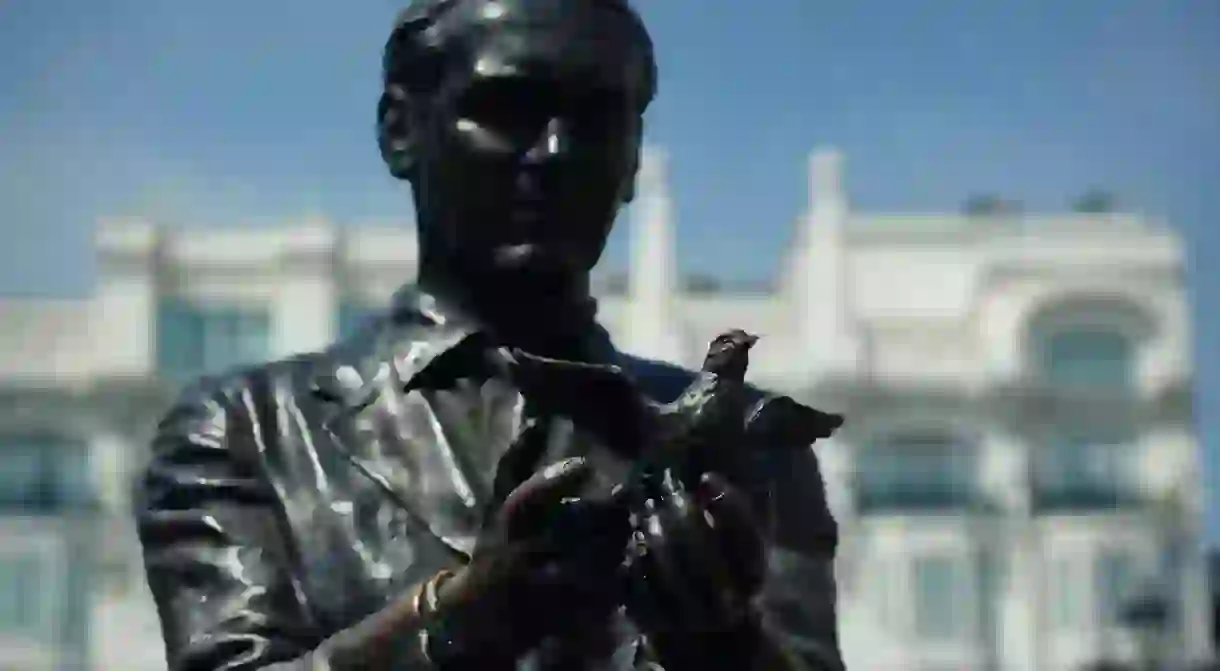A Brief Introduction to Federico Garcia Lorca in 6 Poems

Granada-born poet Federico Garcia Lorca (1898–1936) was arguably the most important Spanish writer of the 20th century. The folklore and Gypsy culture of his native Andalusia provided much of his inspiration and subject matter, as did love, mortality, Flamenco and bullfighting. Lorca was murdered by fascist soldiers in 1936, at the beginning of Spain’s Civil War, and the exact whereabouts of his final resting place is unknown, facts that have only enhanced the appeal of this deeply romantic poet.
‘Autumn Song’ (from Book of Poems, 1921)
Written in Granada in 1918, ‘Autumn Song’ was published as part of 1921’s Book of Poems, Lorca’s second collection of works. It is an exquisitely melancholy reflection on mortality and love, a young man’s first grapplings with questions of meaning and purpose. ‘The hurt of my sadness/moistens memories/in thought’s fountain’, writes the 20-year-old poet*, revelling in his sad introspection. To mirror Lorca’s uncertainty about the profound themes of this poem, the stanzas are scattered with unanswered questions, questions that imply – unthinkably to the young romantic – that love and goodness may be illusory.
‘The Guitar’ (from Poem of the Cante Jondo, 1921)
One of the cluster of short poems that together make up Lorca’s Poem of the Cante Jondo (Poem of the Deep Song), ‘The Guitar’ is a brilliant example of how much feeling and drama the poet could pack into a few lines of verse. Lorca wrote the majority of these poems in November 1921 to prepare for a flamenco festival in Granada the following year. In this work, the sound of flamenco guitar is described as a ‘sob’ that cannot be silenced once it begins. The guitar, writes Lorca, ‘sobs for distant things’, such as the scorched landscape of Andalusia, Flamenco’s true home. Lorca attributes an elemental power to the guitar’s music: like the wind or the snow, it is a natural force that cannot be resisted.

‘The Shout’ (from Poem of the Cante Jondo, 1921)
Critics have pointed out that in his Flamenco poems, Lorca was not concerned with literal descriptions of the music, but with evoking its sounds and effects by other means. ‘The Shout’ provides a powerful demonstration of this technique, in which the piercing wail of the singer’s first notes – introduced by the guitar’s ‘sob’ in the preceding poem – are likened to an ‘arc’, a ‘black rainbow’ stretching over the countryside at dawn. To anyone familiar with the often shocking emotion and sadness present in Flamenco song, this image will resonate strongly. Another striking simile follows afterwards, in which the singer’s cry is compared to a ‘viola bow’ that ‘makes the wind’s long strings vibrate’.

‘Ballad of the Moon, The Moon’ (from Gypsy Ballads, 1928)
The poems of Lorca’s most famous collection explore the life and culture of Andalusian Gypsies, a people that Lorca was fascinated by and about whom he wrote with deep understanding. In this, the first of the Gypsy Ballads, the poet introduces the moon as an important character, a seductive and faintly malevolent being who comes to a blacksmiths at night to kidnap a young boy. Vivid imagery – the moon has ‘hard metallic breasts’ – is combined with hypnotic rhythms: ‘Run, moon, moon, moon’ – to create a dreamlike scene, rich in the emblems of rural life (horsemen, a forge, rugged countryside).
Lament for Ignacio Sánchez Mejias (1934)
Lorca’s lament for the famous Andalusian matador Ignacio Sánchez Mejias, fatally gored during a bullfight in August 1934, powerfully conveys the shock of sudden death. The first section subtly moves between descriptions of the funeral procession and the goring itself. An endlessly repeated line, ‘at five in the afternoon’– referring to the hour of his friend’s funeral, and perhaps the time of his death in the ring – takes on a hypnotizing morbidity as the stanzas progress. A refrain of denial – ‘I will not see it’ – rings through the second section, but in the third and fourth this denial is conquered, and gives way to a recognition of permanent loss. The poet concludes by paying tribute to his friend’s ’embracing of death, the taste of its kiss’ – lines that also acknowledge the mortal risk inherent in the life of any bullfighter.

‘Night of Sleepless Love’ (from Sonnets of Dark Love, 1936)
The poems collected under the title Sonnets of Dark Love were inspired by Lorca’s love affair with Rafael Rodríguez Rapun, an engineering student whom he had met in 1933. The last of these works captures, in just four densely packed verses, a restless night of recriminations and intense passion, eventually terminated by dawn breaking over the writer’s ‘shrouded heart’. Despite its brevity, all of the turmoil and uncertainty of being in love is captured in this poem – a turmoil and uncertainty that prefers the darkness at its backdrop and only briefly recedes during daylight hours.
*All quotes are from Federico Garcia Lorca: Selected Poems (Oxford University Press, 2007), translated by Martin Sorrell with an introduction and notes by D. Gareth Walters.













